4、Pest of the lemon
① Coccoidea
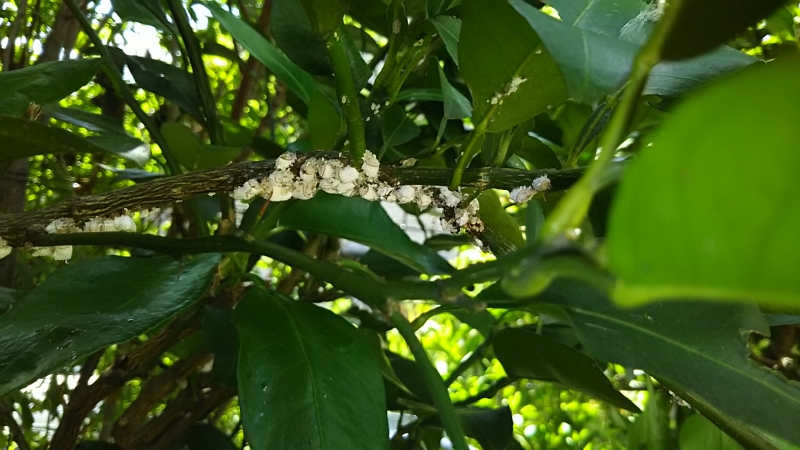
👉 What is a coccoidea?
Coccoidea is the same classification as cicadas, aphids, stink bugs etc. The proliferation becomes popular in the spring warming May - July, and it gets dormant when the winter cold season comes. Coccoidea prefer dark and narrow environments where winds do not pass much and are dusty. So, when branches get crowded, cut the branches so that the wind passes well. Also, let the sun come into contact with the inside.
The coccoideas are small insects about 2 - 10 mm in length, inserting their mouths into leaves and stems, sucking sap and growing. Moreover, it does not move almost after parasitic on plants.
👉 If you leave the coccoideas・・
There are direct damage and indirect damage. The direct damage is that the coccoideas attached to the trees impair the aesthetic appearance. And, the tree sap is sucked and has an adverse effect on the growth of the tree. When the number of parasitism is large, the way new treetops and new leaves get bad and sometimes wither.
Indirect damage is that "soot disease" breeds on the excrement and the leaves turn black. In addition to deteriorating the aesthetic appearance, the photosynthesis which is important to plants is hindered and the growth becomes bad. In addition, it induces "Koyaku disease" that velvet-like objects seem to have adhered to the parasitic places of the branches.
👉 Removal method
・When spraying lubricant emulsifiable concentrate etc. around January
it is possible to suppress occurrence of coccoidea.
During larvae, pesticides etc. are effective because they cover nothing. Since larvae hatched from eggs are weak against drugs, they can also be exterminated with Ortran wettable powder, actelic emulsion and so on. It seems difficult to judge when larvae have appeared. Even if the appearance of the coccoidea can not be seen, it seems that even if it is sprayed at the rate of about 2 to 3 times a month from May to July as a guide, it will be no longer around August.
・Rub it off with a toothbrush.
The more adults become, the more nutrition and excrement accumulates, the shell covers the body. As shells are made, the medicine becomes less effective, so it seems that the method of rubbing and dropping is effective. I rub it off with a toothbrush. Coccoidea peeled off from the branch leaves its mouth in the branch, so it can not be fed afterwards and dies.
② Larva of the swallowtail butterfly
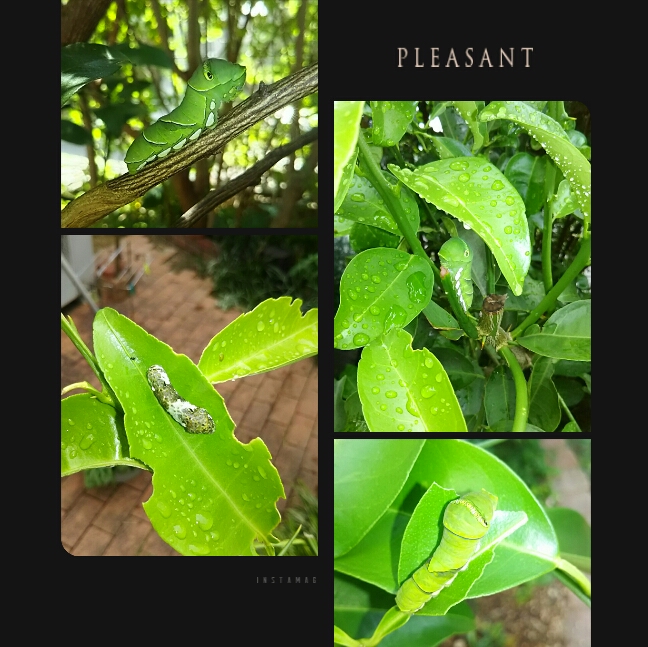
Perhaps it is the greatest enemy of lemon? The larvae have a strong appetite and eat leaves. If there are several larvae, they will eat most of the leaves of one branch in a short time. It goes without saying that a lot of leaves are necessary to raise lemon fruit. Also, if the number of leaves is small, the growth of trees is also hindered. It is good to remove it as soon as you find the larva. Special attention is required after adults have visited.
As the larva grows the medicine becomes less effective. So it is basically to spray medicines early. If larvae of April - May and October are young, there will be little damage and seem to get rid of easily.
If the lemon trees are big, even if the larva of the swallowtail butterfly is attached, it is eaten by the natural enemy, so it will not increase so much. So, it seems necessary to pay particular attention to the time of young trees.
③ Citrus leafminer (Ekakimushi)
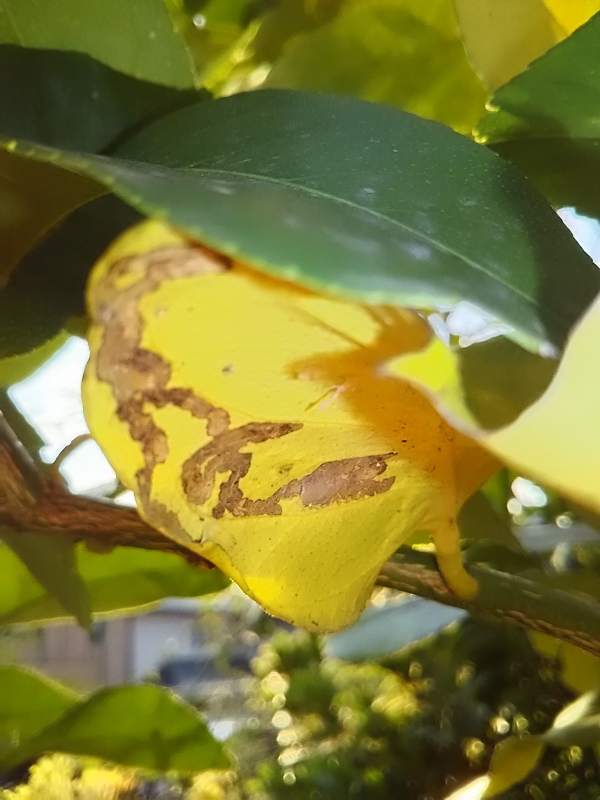
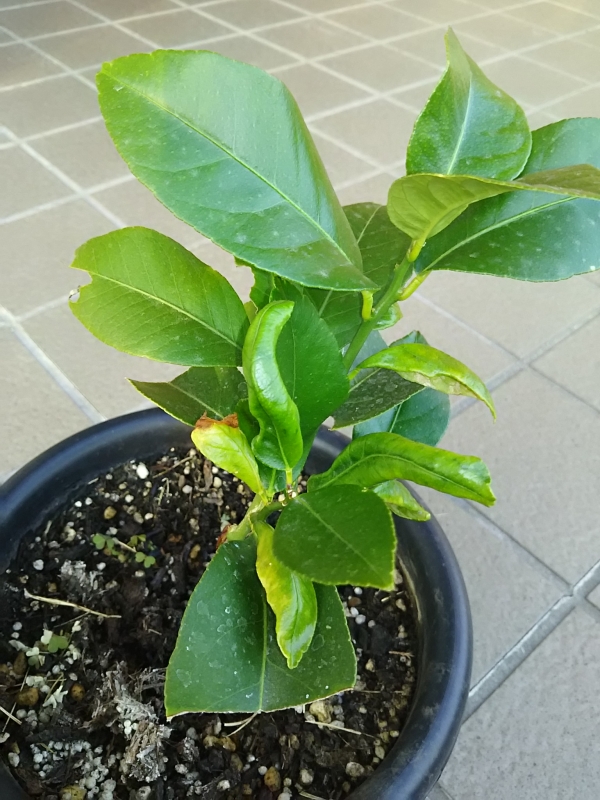
👉 What is Ekakimushi (means Drawing insects) ?
It is called alias "Ekakimushi" in order to leave a trace of food damage as if a larva of Leafminer or Agromyzidae drew a picture on a leaf. "Leafminer" attached to lemon is often "Citrus leafminer". And, when Citrus leafminer becomes a pupa, it folds the leaves and spends them.
The damage of Citrus leafminer is often seen in the leaves of the shoots that occur after the summer. The leaves of the shoots that occur in the spring are hardly damaged. It seems to be because it is before the temperature rises.
Citrus leafminer, as adults, will cross the winter at the back of the leaves or between the bark. The following reasons are cited as reasons for less damage on branches and leaves of spring. It seems that it is said that it is because the survival rate is low because it dies in cold during overwinter or because it is eaten by something.
👉 Damage to Citrus leafminer (Ekakimushi)
By being eaten by Citrus leafminer, trees will never die. However, the shape of the leaves may be distorted, causing fallen leaves, poor growth. If you do not take care of it, damage will spread quickly. On the other hand, there is also a statement that "Most of the orange farmers do not exterminate the citrus leafminer, leaving them alone." This seems to be because there is little damage to the spring branch where the fruit is growing, and it is trying to stretch only the spring branch.
👉 Removal method
Because ekkimushi is inside the epidermal tissue of leaves, pesticides are hard to be effective. Because there are larvae at the tip of the traces of eating, we crush and kill that part with fingers, tweezers etc etc.
<Cultivar control method>
◆Remove unnecessary summer and autumn branches.
<Drug control method>
◆Control with mospiran water solvent or Admire flowable etc. every 2 weeks.
◆For young trees, distribute Akutara water solvent 25 times solution etc. to the main trunk.
Besides this, it seems that there are such things as Calphos emulsion (isoxathione), Spinoose Flowable (Spinosad, wettable powder), Mospiran water solvent (Acetamiprid), Elsan emulsion (PAP) etc that are often used to Citrus leafminer (Ekakimushi).
④ Bell moth
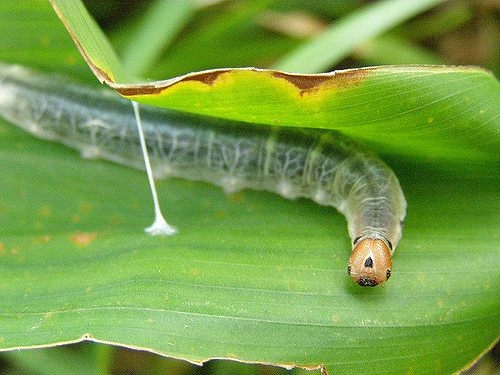
👉 What is Bell moth? (Hamakimushi)
Hamakimushi is a larva of the bell moth. Representative bell moth are Homona magnanima, Adoxophyes orana etc. Roll the leaves with threads that they put out, live in it, and eat leaves and sprouts. Repeated occurrences 4-5 times a year, adults and larvae always occur between April and October.
👉 Damage of Bell moth
Bell moth rolls leaves, it eats leaves and sprouts together. Also, beauty is also impaired.
👉 Removal method
Crush the larvae in the rolled leaves and get rid of them. It is also effective to crush larvae wrapped in leaves during the inactive winter.
When using medicine, periodically spray Sumithione emulsion, Oltrran solution / wettable powder, marathon emulsion etc. once or twice a month at the time of occurrence in April to October.
⑤ Aphid

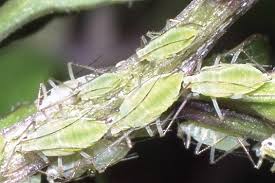
👉 What is aphids?
Aphids parasitic on new plant buds and new branches and leaves behind, and sucking nutrients in plants. There are so many kinds, there are more than 700 kinds. Aphids are representative pests parasitic on plants. Since aphids occur in large quantities and harm plants, the damage can not be ignored and the growth of plants becomes markedly worse.
There is a period of breeding only by females, and when the spawning season comes, males appear, mate eggs and overwinter with eggs. Especially in the early spring, breeding is remarkable, it occurs extensively. In the breeding season, female adults directly bred several female larvae to several to tens of larvae a day. Moreover, since larvae become adults in a few days, even if there is only one, there will be a great many numbers in a few days.
Because aphids are weak against heat, they are not seen much in the summer. In the beginning of the summer, aphids with wings are born and moved to another place. In autumn it will return and repeat breeding.
👉 Damage by aphids
Aphids suck and damage plants juice. As a result, new leaves do not spread sufficiently, growth of stems is compromised, and growth becomes worse. As representative damage, growth of new buds shrinks, leaves are rolling, etc. When the winged aphid that has inhaled the juice of the plant infected with the viral disease moves to the next healthy plant and sucks the juice, the virus invades and infects. In addition, "Cercospora leaf mold(soot disease)" breeds on aphids excrement, leaves may become black.
👉 Removal method
Although many medicines work against aphids, it is effective to use a penetrating agent that is long lasting because aphids are vigorous breeding. If you want to get rid of aphids and other pests, orthranes are effective. Also, especially when removing aphids, "the best guard" and "Mosppran granules" that are effective about 1 to 2 months are good. We also recommend a convenient insecticidal fungicide "BENICA X series" that can prevent and treat diseases at once. For vegetables just before harvest, we will control with Benika mild spray using food ingredients. Since aphids are prone to occur under conditions of high nitrogen content, fertilizer should be discreet. Also, in places with good ventilation, fecundity will become dull, so it is effective to improve the sunlight and ventilation.
It is also effective to release the ladybug which is a natural enemy of aphids. Ladybugs prey on aphids, both adults and larvae.
⑥ Spider Mite (Mikanhadani)
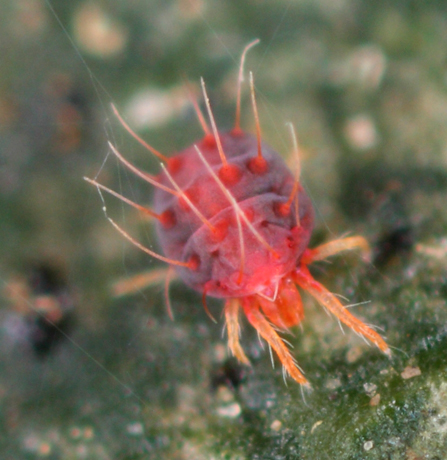
👉 What is Spider Mite (Mikanhadani)?
Spider mites are friends of spiders and have eight legs. The body length is about 0.5 mm and it is difficult to see with the naked eye. Adults lay eggs several times on the back of leaves every day. Larvae hatched in 2 to 3 days will be adults in about 10 days, so they will oc
cur in large quantities in a short period of time. Adult worms do not have wings, so the range of action is not wide, but there is a habit of going up to high places, sometimes being carried away by the wind and being carried far. Spider mite prefers high temperature dry environment, it seems to be a peak of occurrence from around the rainy season to around September.
👉 Damage to spider mites
Spider mite pierces the mouth into the leaves and sucks the juice, so the tissue of that part is broken and it turns white. As a result, color dropouts appear on the leaves like small white spots. When it occurs frequently, the whole leaves become white and discolored, leaf falls and withers because photosynthesis can not be done. In general, damage to garden tree / fruit is not big, but it will impair aesthetic looks.
👉 Removal method
Because spider mite is easy to resist against drugs, eradication seems to be difficult.
<Do not use drugs>
It's difficult to discover because the body is small, but frequently it will be removed with adhesive tape etc. and rinsed off with water before the number increases.
<Use drugs>
*Winter control
It can suppress the increase of spider mites until mid - June. If it is 95%, it will be 40 times, if it is 97% it will make machine oil emulsion which is 80 times and it will be sprayed from late November to January.
*Control when frequent occurrence
Spider mites are frequent from rainy season to around September. If occurrence of indigenous natural enemies is seen, we will skip control at this time. Sprinkle acaricide. Encourage repeated spraying to prevent the development of drug resistance.
Drug・・・Kanemite, colomite, daniemon, machine oil, etc.